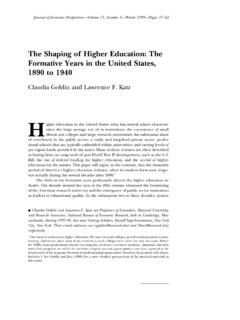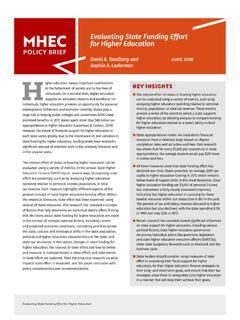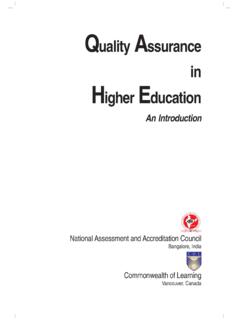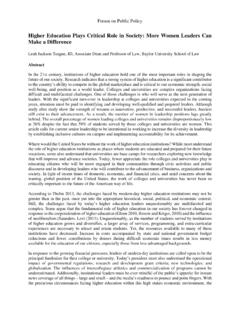Transcription of Higher Education in Japan - 文部科学省ホームページ
1 Higher Education in JapanHigher Education Bureau, Ministry of Education , Culture, Sports, Science and TechnologyContentsIntroduction1. Current circumstances surrounding Japanese Higher Education (1) School system(2) Percentage of students enrolling in Higher Education institutions (3) Establishment status and number of Higher Education institutions(4) Incorporation of national and public universities(5) Development of private universities2. Main issues surrounding university Education 3. Development of quality assurance system(1) Establishment approval system (2) Quality assurance and accreditation system (3) Autonomous quality assurance activities4. Enhancement of university Education function(1) Enhancing undergraduate Education (2) Realization of Graduate Education as "Schools" (3) Considering reorganization of the university system and its Education centered on academic degree program (4) Introducing the system for sharing facilities and materials with researchers around the country5.
2 Internationalization of universities(1) Introducing classes in English (2) Framework of the 300,000 International Students Plan (3) Developing 30 Universities as centers for internationalization (Global 30)6. Current state and issues on public expenditure in universities(1) Types of funding for universities (2) Continuous support for Education and research activities (3) Supporting internationally competitive projects and COE (Center of Excellence)/ GP (Good Practice) projects(4) Financial support to students (5) Recent trend in major financial support7. Education from a Mid-to Long-term Perspective- Deliberation bills for the Central Council for Education ( ,2008) -IntroductionIn the age of knowledge-based society and ongoing globalization, Higher Education institutions have been asked to play increasingly important such circumstances, Japanese Higher Education has been highly appreciated.
3 Excellent and diverse Education and research activities have been promoted under the well-balanced coordination with the establishment approval system and the quality assurance and accreditation system, which is continually reviewed for more efficient Japan , academic freedom has been respected, as the Constitution of Japan stipulates that every citizen shall be entitled to equal opportunities to receive Education in accordance with concerned laws and according to his or her , it should be emphasized that the Fundamental Law of Education stipulates that the independence, autonomy and the merits of Education and research by Higher Education institutions shall be respected. This principle of self-governance has been assured by Japanese Supreme Court pamphlet aims to deliver current situation and some issues surrounding Japanese Higher Education , and we hope that the readers find the information contained here useful, especially for those in charge of Higher Education policies, as well as prospective students and professors who are considering coming to Japan , Higher Education starts upon completion of a total of 12 years of primary Education (6 years in elementary school) and secondary Education (three years respectively in both lower and upper secondary schools).
4 Japanese Higher Education institutions include universities awarding bachelor s, master s, doctor s and professional degrees, junior colleges awarding associate s degree, and colleges of technology, where lower secondary school graduates are admitted and receive practical and creative completion Education throughout a five-year period, and specialized training colleges (specialized schools) which offer specialized courses for the purpose of developing professional or practical abilities or to foster Current circumstances surrounding Japanese Higher Education (1) School system Academic degrees awarded by Higher Education institutions and the standard periods required to obtain such degreesOrganization of the School System in Japan Degrees awarded by Higher Education institutions and standard periods required to obtain such degrees UniversityBachelor s degreeFour yearsGraduate schoolMaster s degreeTwo yearsDoctor s degreeFive yearsProfessional degreeTwo yearsJunior collegeAssociate s degree Two or three yearsCollege of technologyAssociate s degree Five yearsSpecialized schoolSpecialist s degreeTwo or three yearsHigh-level specialist s degreeFour years Degrees of specialist and high-level specialist shall be given to graduates of specialized schools that can meet certain standards designated by the Minister of Education , Culture, Sports, Science and Technology.
5 Of undergraduate courses, the standard period of those of medicine, dental surgery, pharmacy to nurture pharmacists, and veterinary science is six years, while the standard period of doctoral courses based on such undergraduate courses is four CoursesCorrespondenceCoursesSchoolNormal Graduate SchoolsSpecialized Training CollegeYearAgeCorrespondenceGeneral Courses24 CoursesSpecializedMiscellaneous Schools18 TrainingCorrespondence23 CollegeCoursesColleges of17 SpecializedTechnology22 CoursesSpecialized16 Training21 UniversitiesCollege UpperSchools for15 SecondarySpecial Needs20 JuniorCoursesEducation14 Colleges19131812 UpperPart-Upper17(Div.)Upper Secondary Lower Secondary Lower Div.) (7 12 6 11 5 Elem-10 Elementary 3 8 18-year-old bracket population = Graduate from junior high schools and those who finished the first stage of secondary schools three years before Advancement Rate 1 = Number of proceeding to Universities, Junior Colleges, Colleges of Technology, Professional Training Colleges18-year-old bracket population Advancement Rate 2 = Number of proceeding to Universities, Junior Colleges18-year-old bracket population Number of Graduates from high schools = Graduates from high schools and those who finished the latter stage of secondary schools Applicant Rate directly from high schools = Number of applicants for universities, junior colleges in high school graduates in the corresponding year18-year-old bracket population Capacity = Number of enrollees to universities.
6 Junior colleges in the corresponding yearNumber of applicant to universities, junior colleges16 182021 2225293133 3333363839414260 6061 61 6145666811121313131414151617171818212222 2324252525242322211917141312111518181920 2022222125272931343536363434343332313131 3334606061606059595958575655545249484747 4441424241414141434342117889101818171818 1818252528303353411111010911011311315618 5140177195197190200249243236213195185174 1671621561541621581561581611641721681881 8819320120420519818617717316816215515115 1150146141137133130124121122120119122117 1191181191171171161091201378711616015693 9610299160150140136132133134133133140139 1381401421451521481621651651701771801811 7616615915515014413613313313212812411711 5107050100150200250300196019651970197519 801985199019952000200520102015202020250% 10%20%30%40%50%60%70%80%90%100%(2) Percentage of students enrolling in Higher Education institutions In Japan , the percentage of 18-year-old population bracket students enrolling in universities and junior colleges has steadily increased since the Second World War to exceed 50% as of now.
7 If the percentages of students enrolling in colleges of technology and specialized schools are added, the total percentage exceeds 70%. Judging from this situation, it is assumed that Japan has already entered the stage of universal access to Higher Education . Change in advancement rate in Japan Reference: School Basic Survey FY2009 Advancement Rate 1 (University + Junior College+ College of Technology+ Professional Training College)Capacity(University+Junior College)Applicant Rate directly from High School(University + Junior College) Junior College of Professional Training Junior Junior 92 5%77 6%61 2%56 2%18-year-old bracket populationPlans of the last half of 70'sPlans of the first half of 80'sPlans of the last half of 80'sPlans afterFY1994 Concept after2000(10,000 persons)Students in the 4th gradeof Colleges of TechnologyStudents entering Professional Training CollegesGraduates from High SchoolsStudents entering UniversitiesStudents entering Junior CollegesAdvancement Rate 2(University + Junior College)(FY)(3)
8 Establishment type and number of Higher Education institutions In Japan , universities are divided into following three categories by its founding basis: national universities, which were originally established by the Japanese Government (currently established by national university corporations), public universities, which are established by local public entities or public university corporations, and private universities, which are established by educational corporations. Both national government and local governments are members of the public sector. However, while a national government represents the nation itself and is managed under the single national rule, local governments are responsible for certain areas, and provide basic services for people living there, responding to voices and situation of the local residents.
9 As for the system of school corporations, the system aims to assign a specific corporative status to any specific individual or organization attempting to manage a regular school. This system aims to render soundness to the management body of such individual or organizations. Corporations shall prevent school management from being exploited for the arbitrariness, interests and personal gain of a selected few, and shall possess the assets required for Education , such as school premises and buildings, in order to provide stable and continuous school Education to enrich and improve their educational conditions. National universities, which have been established in all local prefectures as organizations targeting the improvement and well-balanced development of Japanese Higher Education and academic research, have played important roles as local research centers etc.
10 In addition, national universities have been reorganized as corporations since 2004, aiming to improve each university s independence and autonomy to enhance Education and research activities. Public universities, which have been established and managed by local public entities or public university corporations, have also played important roles in providing Higher Education opportunities to local people and as intellectual and cultural centers in the local community. Private universities have accounted for about 80% of all universities and have had about 80% of all university students on their registers. Each private university has promoted its own unique Education and research activities based on the spiritual legacy of its foundation. They have played important roles both qualitatively and quantitatively, and have greatly contributed to the development of Japanese Higher Education .













